Mango has long been considered the king of fruits in India, as it is the country’s leading fruit crop. It is delicious, has an excellent flavor and pleasant fragrance, and is rich in vitamins A and C. As being hardy, it can grow in various soils, is relatively easy to care for, and requires relatively little maintenance. Both the immature fruit and the mature fruit of the Mango are used in varying ways during its development.
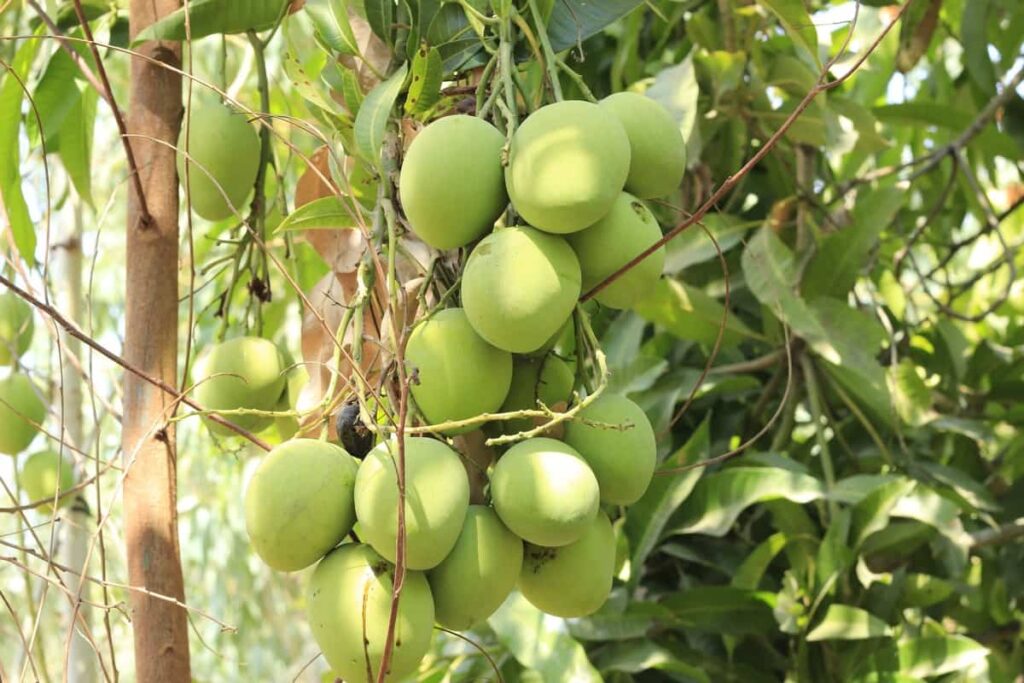
Raw fruits are used as ingredients when preparing chutney, pickles, and juices. It should also be noted that this fruit is used not only for desserts but also for preparing several products, including squash, syrups, nectars, jams, and jellies. It is believed that Mangoes originated in the Indo-Burma region, which is still a notable center of Mangifera diversity today.
Over one thousand varieties of Mangoes are grown in India, of which about 150 are known for their unique taste and flavor, making them a popular product in India. However, it is essential to note that only about thirty varieties of this fruit are grown commercially in different parts of the country. Let’s check out high yield hybrid mango varieties in India below.
Scope for Mango cultivation and its national importance
With around 23% of the total area under Mangoes, Uttar Pradesh and Andhra Pradesh have the larger areas under Mangoes, followed by Karnataka, Bihar, Gujarat, and Tamilnadu, with 16% of the total area under Mangoes. Mangoes and Mango pulp are some of India’s most essential agri-exports in terms of quality and quantity. The main markets for India’s Mango exports are the UAE, Bangladesh, the United Kingdom, Saudi Arabia, Nepal, Kuwait, the USA, and other Middle Eastern countries, with a limited quantity of Mangoes exported to Europe.
It is worth noting that, despite India being the largest Mango-producing country in the world, accounting for about 45% of the world’s production, the fresh fruit exported is mainly Alphonso and Dashehari. India is estimated to hold a share of about 15 percent of the global Mango market. As a percentage of the country’s total fruit exports, Mangoes account for 40 percent of that total. In the country, there is good potential for increasing the area and productivity of Mangoes by increasing their production.
| State | Varieties grown |
| Andhra Pradesh | Allumpur Baneshan, Banganapalli, Bangalora, Cherukurasam, Himayuddin, Suvernarekha, Neelum, Totapuri |
| Bihar | Bathua, Bombai, Himsagar, Kishen Bhog, Sukul, Gulab Khas, Zardalu, Langra, Chausa, Dashehari, Fazli |
| Goa | Fernandin, Mankurad |
| Gujarat | Alphonso, Kesar, Rajapuri, Vanraj, Jamadar, Totapuri, Neelum, Dashehari, Langra |
| Haryana | Dashehari, Langra, Sarauli, Chausa, Fazli |
| Himachal Pradesh | Chausa, Dashehari, Langra |
| Jharkhand | Jardalu, Amrapalli, Mallika, Bombai, Langra, Himsagar, Chausa, Gulabkhas |
| Karnataka | Alphonso, Bangalora, Mulgoa, Neelum, Pairi, Baganapalli, Totapuri |
| Kerala | Mundappa, Olour, Pairi |
| Madhya Pradesh | Alphonso, Bombay Green, Langra, Sunderja, Dashehari, Fazli, Neelum, Amrapalli, Mallika |
| Maharashtra | Alphonso, Mankurad, Mulgoa, Pairi, Rajapuri, Kesar, Gulabi, Vanraj |
| Orissa | Baneshan, Langra, Neelum, Suvarnarekha, Amrapalli, Mallika |
| Punjab | Dashehari, Langra, Chausa, Malda |
| Rajasthan | Bombay Green, Chausa, Dashehari, Langra |
| Tamil Nadu | Banganapalli, Bangalora, Neelum, Rumani, Mulgoa, Alphonso, Totapuri |
| Uttar Pradesh | Bombay Green, Dashehari, Langra, Safeda Lucknow, Chausa, Fazli |
| West Bengal | Bombai, Himsagar, Kishen Bhog, Langra, Fazli, Gulabkhas, Amrapalli, Mallika |
In case you missed it: Roma Tomato Growing Guide: For Pots, Ground, Raised Beds, and Buckets
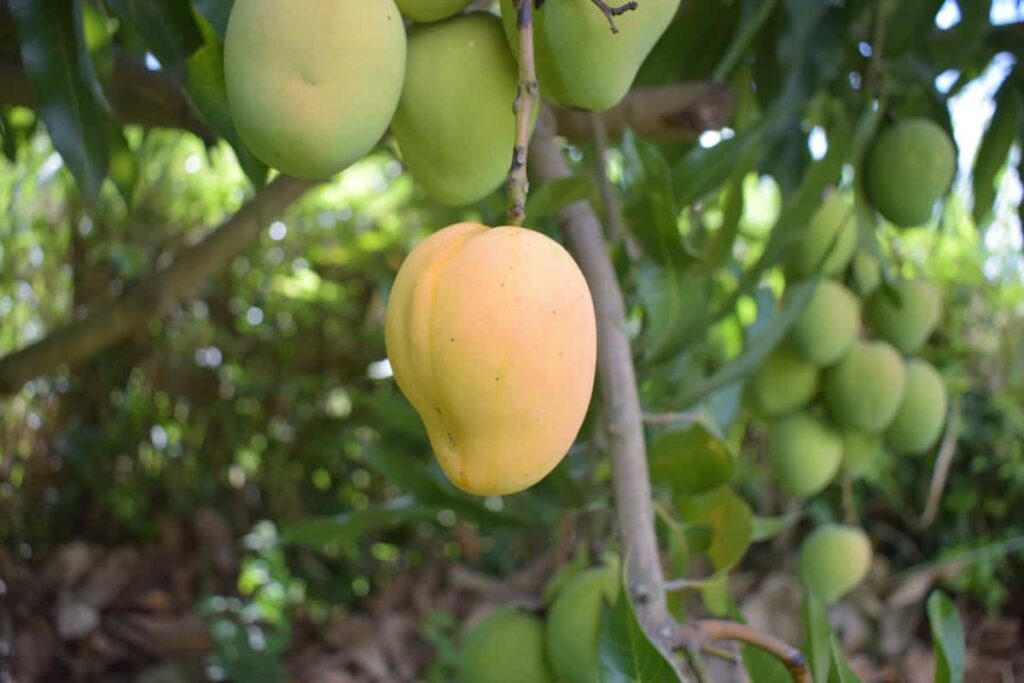
High yield hybrid mango varieties in India
Amrapali
This hybrid is made up of a cross between Dashehari and Neelum. It is a dwarf variety with standard bearing and a late maturing period. The variety is suitable for high-density planting as about 265 plants may be planted in one acre. It yields an average of 6.5 tonnes per acre.
Arka Aruna
It is a hybrid of Banganapalli and Alphonso. It is a dwarf, regular bearing, and precocious tree. In addition to the large size and attractive skin color with a red blush, the fruits are free of spongy tissue, which makes them very desirable. Homesteads and high-density plantings will benefit from the planting of this variety.
The number of plants that can be accommodated per acre is about 200. The fruits are generally large (500-700 gm), with an attractive color on the fruit’s skin. In addition to being fibreless, the pulp is also sweet. As far as the pulp percentage is concerned, it is 73 percent, and the fruit tissue is free of sponginess.
Mallika
The Mallika Mango is an Indian variety that is vigorous, highly productive, and disease resistant. It is considered one of the finest among the top dessert-quality Mangoes of the Indian type. Mallika Mangoes are a variety of Mangoes that cross between Dasheri base Mangoes and Neelum graft Mangoes. There is a generous amount of sweet pulp in each fruit, which is medium-sized with a fragile seed.
When consumed fresh, this Mango variety naturally ripens mid-season and tastes best when consumed within a few days of harvest. There is no doubt that this Mango is excellent for juicing and dehydrating. For the fruit to ripen properly, it must be picked green at maturity, packed in a cardboard box, and kept at room temperature for some time. The process of ripening usually takes between two and three weeks.
In case you missed it: High Yield Hybrid Paddy/Rice Varieties in India: For Rabi and Kharif Seasons
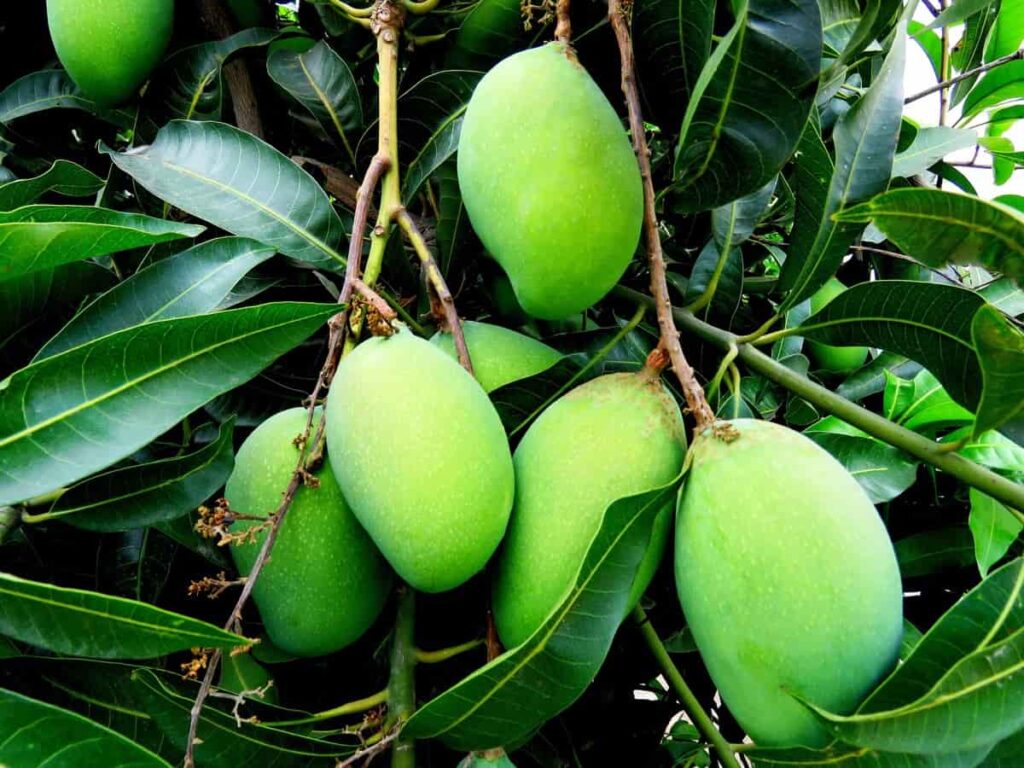
Arka Puneet
The hybrid from the cross between Alphonso and the Banganapalli plant is a regular and prolific bearer. The fruits vary from 200 grams to 250 grams and have red-blushed skin, making them very attractive to the eye. In terms of pulp percentage, the pulp percentage is 70 percent, which is free from the fiber. In addition, the fruits have a good taste and keeping quality and are free of spongy tissue. Also, it is a good variety for processing as well.
Arka Udaya
The Indian Institute of Horticultural Research (IIHR) introduced a new late-season variety of Mangoes called ‘Arka Udaya.’ Amrapali is crossed with Arka Anmol to create Arka Udaya. Mangoes of this variety are sweet, high-yielding, and have a long shelf life, making them ideal for preserving. It can be preserved at room temperature without refrigeration for about ten days. It is one of the late-season varieties of Mango fruit trees, which yields fruit after other Mango trees have finished bearing fruit. yield per acre was estimated to be around 8 tons, which was a high yield.
Pusa Surya
The plants of this variety are semi-vigorous, and it is a regular bearer variety. Thus, it is suitable for planting closer to each other (6 m x 6 m). In addition, it is less susceptible to Mango malformation than Amrapali, and other commercial cultivars are grown in northern India. In general, it usually ripens by the end of the third week of July.
It is a medium to large fruit (270 g) with a good apricot yellow peel color and medium levels of total soluble solids, about 18.5%. The fruit’s pulp has a high vitamin C content of about 42.6 mg per 100 grams. When it is ripe and stored at room temperature, it has a shelf life of 8-10 days at room temperature. In addition to being suitable for the domestic market, it is also suitable for the international market.
Pusa Prathibha
It is a hybrid derived from a cross between Dashehari and Amrapali developed by the Indian Agricultural Research Institute in New Delhi. It is a regular-bearing variety with a fruit shape that is attractive and has a bright red peel and an orange pulp, and there is a semi-vigorous nature to the plants. It has a good balance between sugar and acid and uniform fruits. The fruit of this plant is oblong in shape and uniform in size.
Pusa Pratibha
It is a unique hybrid from Amrapali x Sensation with a regular bearing, an attractive fruit shape, bright red peels, and orange pulps. It is attractive to buyers because of the red peel color on the golden-yellow background. The fruits of this plant are uniform in size and have an oblong shape. In addition to meeting all the requirements for the domestic market and international.
The shelf life of this product is 7 to 8 days at room temperature after it has been ripened. It is estimated that approximately 112 plants of this hybrid can be grown in an acre (6 m x 6 m) of soil, and the plants are semi-vigorous. It is therefore expected that it will give a higher productivity per unit area as a result. This variety offers a much higher yield per plant as compared with Dushehari.
In case you missed it: 22 Agricultural Apps for Smart Farming Solutions: Help with Farm Management, Soil, and Crop Yield
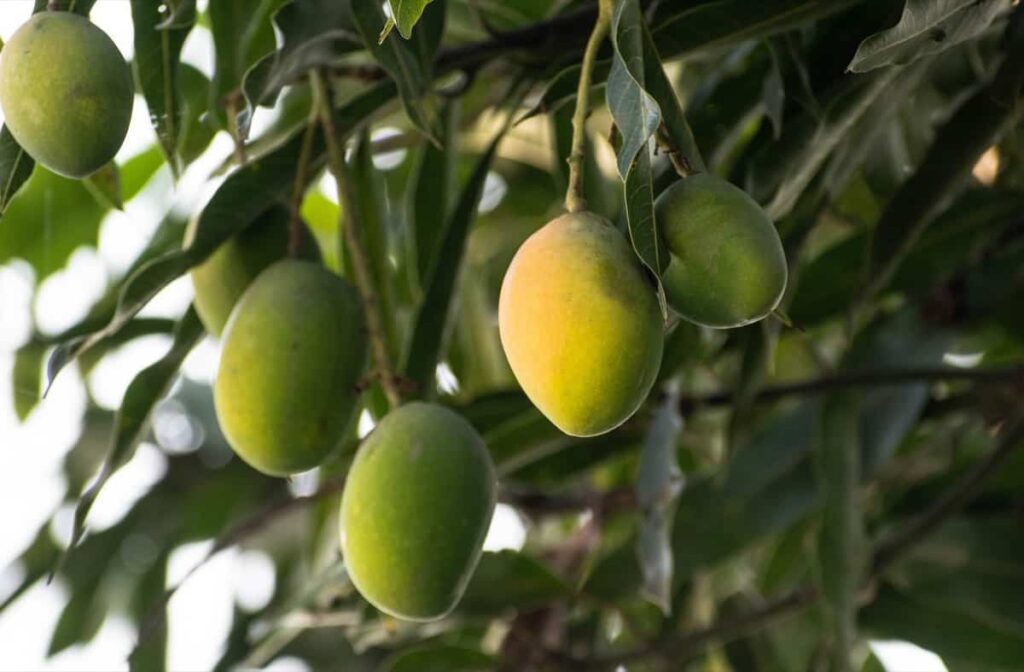
Pusa Shresht
This plant is a cross between Amrapali X Sensation developed by the Indian Agricultural Research Institute, New Delhi, a hybrid of both plants. The trees are semi-vigorous, regularly bearing elongated fruits with attractive red peels, and have a semi-vigorous habit. During ripening, the pulp is orange, fibreless, and firm. There is a moderate sugar: acid blend with a uniform fruit size (228g). As a result of its elongated shape, it is suitable for packaging products in uniform sizes.
Besides meeting the requirements for the domestic market, it also meets the requirements for the international market. There is a shelf-life of seven to eight days at room temperature after the fruit ripening. Approximately 112 plants of this hybrid can be accommodated in an acre (6m x 6m). As a result, it contributes to higher productivity per unit area.
Pusa Deepshikha (Hybrid 11-2)
This hybrid of ‘Amrapali’ and ‘Sensation’ produces fruits that are uniform in size and exhibit regularity in bearing. It has an oblong, bright red peel with an orange-yellow pulp, moderate TSS (18.67%), and high pulp content (70%). In terms of shelf life at room temperature, this variety has a good shelf life of seven to eight days. It fits into medium-density planting situations (6 m x 6 m) as a semi-dwarf. Concerning yield per tree, it yields 50.33 kg (approximately ten-year-old trees) and an approximate yield per acre of 6 tons.
Pusa Peetamber
It is a unique hybrid (Amrapali x Lal Sundari) with the regularity of bearing an attractive oblong fruit shape with a distinctive orange color. Due to its oblong shape, it is quite suitable for uniform packaging. During the process of ripening, the yellow color of the fruit makes it very appealing to buyers. The product is designed to meet all the requirements of domestic and international markets.
Once it has been ripened, it has a shelf life of 5 to 6 days at room temperature. There are around 112 plants of this hybrid that can be cultivated within an acre (6 m x 6 m) of soil due to its semi-vigorous nature. As a result, the productivity per unit area will be higher as a result of this. In terms of yield per plant, it is about twice higher as Dushehari.
PusaManohari (Hybrid 8-11)
It is a regular-bearing Amrapali x Lal Sundari hybrid with field tolerance to Mango malformation (10-15%). The trees are semi-vigorous and are suitable for medium-density planting (6 m x 6 m). A greenish-yellow peel characterizes the medium-sized fruits (223 g) with a red tinge on the shoulders, yellowish-orange pulp that is fibreless, and a high level of TSS (20.38%). It is estimated that the annual yield of the tree is 58 kg (approximately ten-year-old trees), with an estimated yield per acre of 6.5 tons annually.
Pusa Lalima
This hybrid results from the cross between Dashehari X Sensation introduced by the Indian Agricultural Research Institute, New Delhi. They are semi-vigorous, regular bearers with attractive oblong fruits with brig bearing, attractive fruit shape, bright red peel, and orange pulp. Something is appealing about the red peel color that contrasts with a yellowish, green background which appeals to the buyers.
In case you missed it: High Yield Hybrid Cotton Varieties in India – For Rabi, and Kaharif Seasons
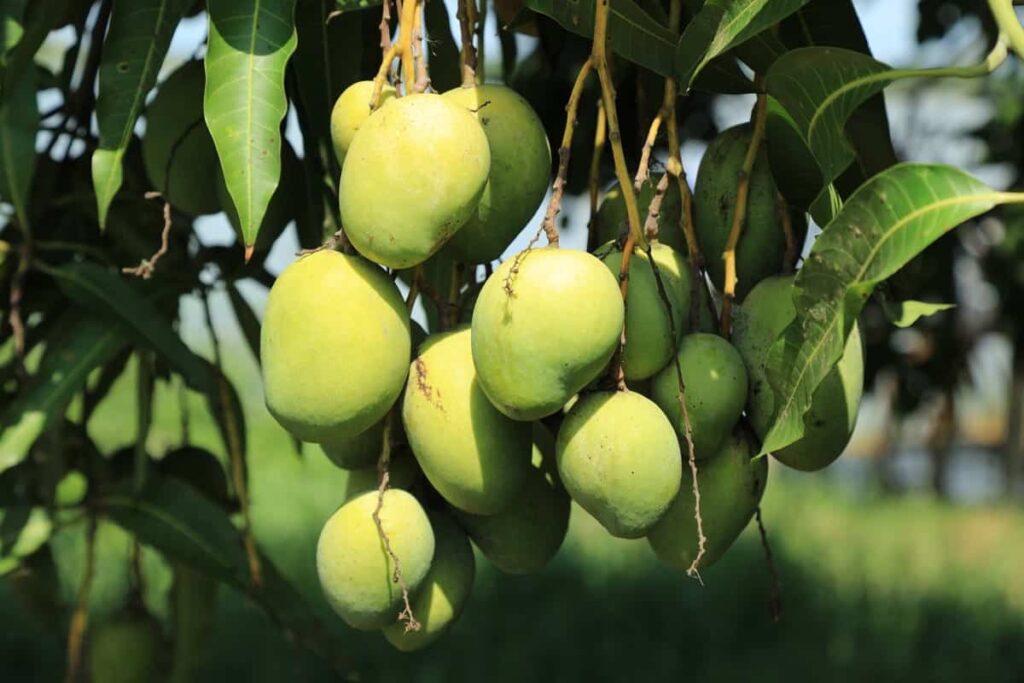
At room temperature, it has a shelf life of about five to six days after it has been ripened. About 112 plants of this hybrid can be accommodated in an acre (6 m x 6 m), and the plants are semi-vigorous. Therefore, the productivity per unit area is expected to be higher. In terms of yield per plant, it is about 4.0 times higher than Dushehari. Furthermore, it has an excellent sugar-to-acid ratio and a uniform fruit size.
Pusa Arunima
The hybrid has been developed from the crossing of Amrapali and Sensation. Plants are semi-vigorous and can be planted closer together (6 m x 6 m). It is a regular bearer and starts bearing after the fourth year of planting. The fruit ripens late in the season and is ready for harvest by the 1st week of August. The fruit size is medium (250 g), and the peel color is attractive red.
TSS is medium (19.56%), and vitamin C content is high (43.6 mg/100 g pup), and it has a good flavor and an excellent shelf-life after ripening (10 to 12 days). Domestic markets are suitable for it. Because of its attractive red peel color, fibreless pulp, and mild flavor can also be accepted in international markets.
Ambika
A hybrid between Amrapali X Janaradhan Pasand was developed by the Central Institute for Subtropical Horticulture, Lucknow. This variety produces medium-sized fruits with a broadly pointed apex, slight sinus, and beak. Fruits are bright yellow with a dark red blush, and the peel is smooth and tough. It is a late-maturing variety with firm pulp and scanty fiber.
Arunika
Developed by the Central Institute for Subtropical Horticulture, Lucknow, it is a hybrid between Amrapali and Vanraj. The fruits of this variety are attractive and have a red-blush color. This fruit is high in total soluble solids and carotenoid content and has a firm pulp. Plants are dwarf in stature, and this hybrid variety is a regular bearer.
Pant Sinduri
Developed at Govind Ballabh Pant University of Agriculture & Technology, Pantnagar, this is a clonal selection of Dashehari. These trees are medium in height with a round canopy, and their fruit is yellow with a pink shoulder. A typical fruit weighs up to 200 grams. The fruit pulp is yellow and has a pleasant aroma. The average yield per tree is 150 kg, with soluble solids ranging from 16 to 18%. The fruit matures between the end of May and the beginning of June.
Harvesting Mangoes
From the fifth year after planting, Mango trees begin to bear fruit. In addition to the variety, the yield also depends on climatic conditions. First-year yields are generally low (3-5 kg per tree), but they increase gradually over time. Depending on the tree’s age, it can produce up to 600 kg of fruit per year. Mangoes are generally harvested early because they continue to ripen once plucked from their trees. By doing so, we capture them early in the market.
In case you missed it: High Yield Hybrid Chilli Varieties in India: For Rabi, Kharif, Winter, Summer, and Rainy Seasons
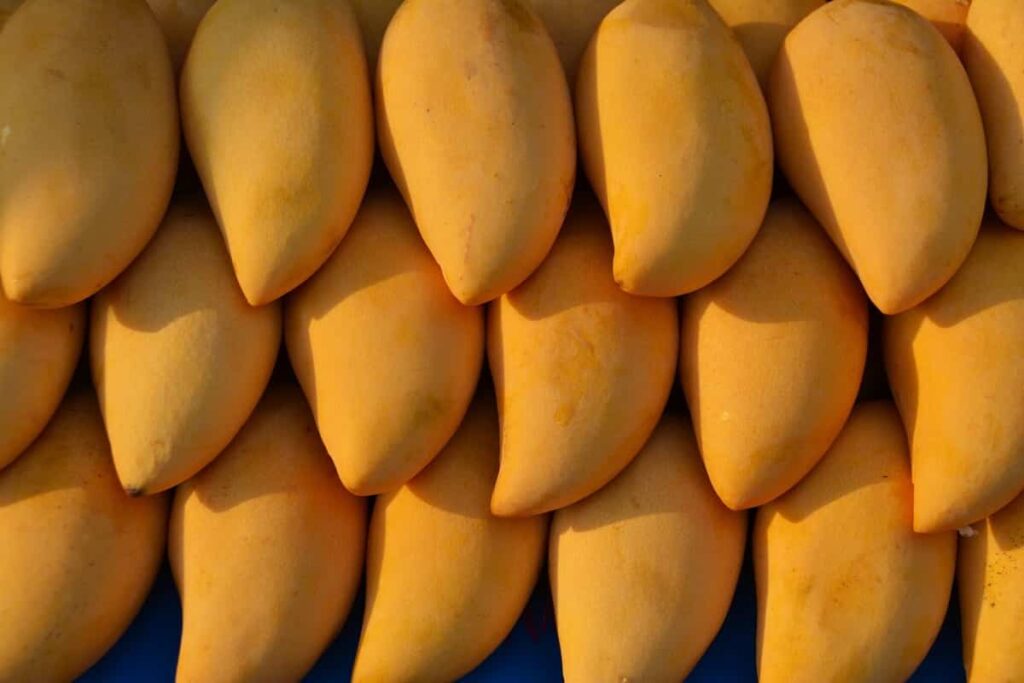
The plucked fruits’ color, size, and maturity stage determine the grade, and smaller fruits are separated from larger ones to achieve uniform ripening. The diseased, damaged, or overripe fruit is discarded at this stage. Fruits are ripened by dipping them in 1.8 ml of ethrel in 1 liter of hot water for 5 minutes. A lower dose of ethrel is used for dipping mature fruits for uniform coloration. At room temperature, mature fruits can be stored for 4-10 days. However, this depends on the variety.
Conclusion
The climate in India is ideal for growing Mangoes since it is a tropical paradise. Due to this, newer varieties are constantly being created and discovered. Choose hybrid varieties that are well adapted to your climatic conditions. These hybrid varieties produce high yields and are resistant to diseases, reducing pesticide usage costs in Mango cultivation from seedling to harvest.
- Profitable Village Farming Business Ideas in 2024
- High-Yield Aquaculture: Fast-Growing Fish for Farming
- Effective Fish Pond Construction Techniques for Beginners
- Irrigation and Water Management in Pineapple Farming
- Blossom to Harvest: Mastering Flowering and Pollination in Papaya Farming
- Pig Fattening Essentials: From Selection to Sale for Beginners
- Raising Wagyu Cattle: A Complete Guide for Premium Beef Production
- Soil Types and Their Water Holding Capacity
- Optimizing Irrigation Schedules for Coconut Groves for Enhanced Yield
- Espresso Your Garden: Coffee Grounds for Healthier Acid-Loving Plants
- The Best Soil Mix for Snake Plants: How to Mix Your Own Snake Plant Soil
- Green Thumb Success: Expert Tips for Cultivating Greenhouse Beans All Year Round
- Bloom All Year Round: The Ultimate Guide to Indoor Hyacinth Care
- Eco-Friendly Gardening: How to Make Liquid Fertilizer from Kitchen Waste
- Ultimate Guide to Grow Anise in Pots: Explore Seed Propagation to Harvesting
- Guide to Raising Chester White Pigs: Discover Breed Facts to Growth Management
- Mastering the Elegance: The Ultimate Guide to Weeping Cherry Tree Care, Planting, and Maintenance
- Ultimate Guide to Planting Garlic in Grow Bags: Growing Strategies for Beginners
- How to Fix Spider Plant Leaf-Related Problems: Natural and Organic Remedies
- 10 Reasons Why Your Tulsi Plant is Shedding Leaves: Home Remedies and Solutions
- Optimizing Growth and Yield: The Advantages of Palm Bunch Ash Fertilizer
- Utilizing Neem Oil Extract as a Natural Pesticide for Hydrangea
- From Soil to Harvest: Various Ways in Which Farmers Can Use AI Tools
- Steps to Encourage and Induce Citrus Flowers: A Comprehensive Guide
- How to Fix Snake Plant Leaf-Related Issues: Natural and Organic Remedies
- Transform Your Garden into a Fragrant Oasis with Raat Ki Rani (Night Blooming Jasmine)
- Discover the Ideal Chicken Breeds for Philippine Farms
- How to Create a Poultry Egg Farm Business Plan for Profits
- Grow Lemon Cucumbers Like a Pro: Insider Techniques for Bountiful Yields
- Ultimate Guide to Caring for Your Pink Princess Philodendron: Tips for Thriving Variegation
- Areca Nut Profit Per Acre: Calculating Yield and Cost of Cultivation
- How Kaveri Chicken is Becoming a More Profitable Breed in Indian Backyards
- Transform Your Barn: 9 Steps to Convert a Horse Stall into a Chicken Coop
- Exploring Suffolk Sheep Disadvantages with Limitations and Challenges
- Guide to Solving Potted Lemon Tree Problems: How to Revive Lemon Tree in Containers
- Steps to Encourage Female Pumpkin Flowers: Best Strategies for More Flowers and High Yields
